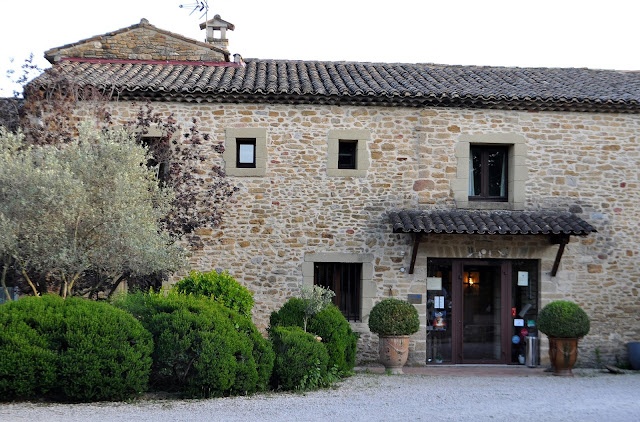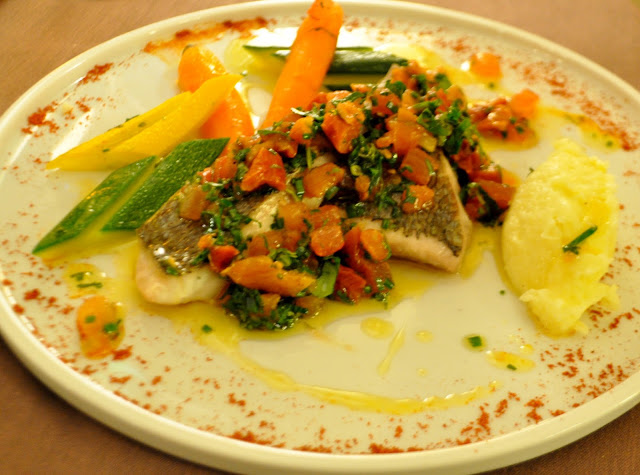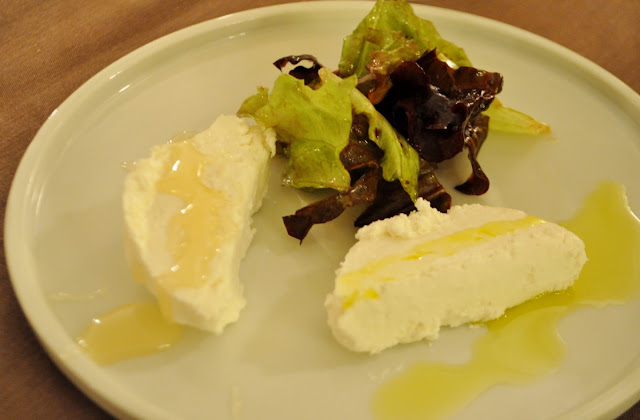As I told you before, we always find several occasions to meet up with cousins Jean Marc and Christine during our sojourns in Sablet. These get-together usually revolve around food; meals at home in Sablet, meals at their house in Clapiers or a restaurant in nearby Montpellier or dinner after they get off work in a restaurant somewhere between Sablet and Clapiers.
One evening last spring, we set a date to meet after work at a restaurant between Sablet and Clapiers. I was tasked with finding the restaurant, a task, you probably know, I relish. One of the first things I do when we get to Provence in the spring, is buy the latest edition of the "Bonne Petites Tables du Guide Michelin."
I immediately check to see which restaurants in our area have been added or dropped from the list of restaurants awarded Bib Gourmand, small charming restaurants offering exceptionally good food for a maximum price of 31 Euros for starter, main course and dessert. I had seen that one of the new additions was just outside of Orange.
The restaurant was open and I decided it would be a good place to meet as at Orange, the A7 tollway intersects with the A9 tollway which continues to western Provence, Nîmes, Montpellier all the way to the border of Spain while the A7 tollway continues south toward Avignon, Marseille and the heart of Provence.
Orange is about 25 minutes from Sablet and best known to wife Shirley and me as the exit off the A7 and A9 toward home to Sablet. Orange is also where our insurance agency is located and the Tresor Public where we pay taxes for our house. Orange is best known to most people for its Roman ruins, especially the Roman theater and the Triumphal Arch of Orange.
I sent a text message to Jean Marc and we agreed to meet at 20:00 (8:00 PM) at Le Mas d'Aigras and La Table du Verger just northwest of
Orange. The restaurant is owned by Savoy native Alain Davi and his wife Sylvie who took over Le Mas d'Aigras in April 1999.
 |
| Le Mas d'Aigras and La Table du Verger |
Le Mas d'Aigras is set in the middle of vineyards, 4 kms from Orange in a shady park-like area with 9 rooms and a pool and the restaurant La Table du Verger. The building originally housed a convent, then a farm, and a winery, before its current incarnation as hotel and restaurant.
 |
| Le Mas d'Aigras and La Table du Verger Dining Room |
Before he and his wife established La Table du Verger, the chef trained with Philippe Million (Relais and Châteaux and 2 Michelin stars), then in Burgundy, at the Saint-Michel Abbey (2 Michelin stars), with Christophe Cussac. He then moved to Avignon, where he cooked at La Mirande Hotel (1 Michelin star) for 8 years, 2 of which he was Chef de Cuisine.
 |
| Le Mas d'Aigras and La Table du Verger Grounds |
As I mentioned, Le Mas d'Aigras and La Table du Verger was awarded a Bib Gourmand by the
Michelin inspectors. This means that they offer exceptionally good food for a maximum price of 31 Euros for a starter, main course and dessert. So we all chose the Menu du Verger for 31 Euros.
To warm up our taste buds, the chef sent out some crudités, olives and gougères to nibble while we waited the arrival of our first courses.
 |
| Amuse Bouche |
 |
| Pan-seared Duck Foie Gras |
 |
| Millefeuille of Local Asparagus with Parmesan Tile and Cream of Tonka Beans |
 |
| Fillet of Sar with Concasse of Fresh and Sun Dried Tomatoes |
 |
| Monk Fish Medallions with Basil and Little Spring Vegetables |
 |
| Fresh Goat Cheese and Salad Greens |
 |
| Cousins Jean Marc and Christine |
 |
| Shirley and me |
 |
| Angelique's Lemon Cheesecake with Red Fruit Coulis |
 |
| Strawberry Soup with White Cloud |
 |
| Babas au Rhum and Pineapple compote |
 |
| Chocolate Cake with Vanilla Custard |
The chef took our orders and served the food. He was very friendly and chatty and told us he prepared all of the sauces and his second assembles the plates. The food and service were excellent. The restaurant was not very busy that night in May. We will return. The location turned out to be even more convenient than originally thought as there is an entrance to the tollway less than 1 km away.
Le Mas d'Aigras and La Table du Verger
Chemin des Aigras
84100 ORANGE
Tel: 04 90 34 81 01
www.masdesaigras.com/uk/index.php
Have a great week. A bientot.
